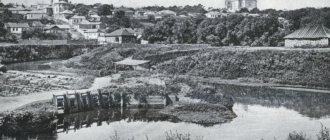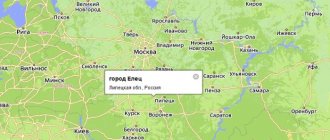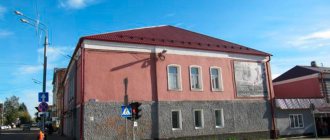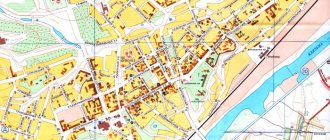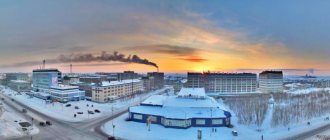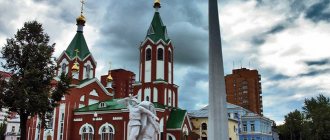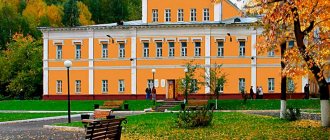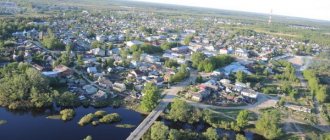Bogoroditsk is a city in Central Russia, the administrative center of the Tula region. Located on the right bank of the Upyorta River (a tributary of the Upa), 65 km southeast of Tula, 240 km south of Moscow. An ancient Russian city. In the center of the city is the Upyorta River, on the high bank of which there is the first landscape park in Russia, and in the park there is a palace-museum of the 18th century. The city has developed road services, as well as the production of clothes dryers and fumigators. Bogoroditsk is a small provincial town, divided from north to south by the Upertaya River, with a traditional radial-ring structure in its western part. Almost the entire eastern part of the city is occupied by the palace museum. The main city thoroughfare is Kommunarov Street.
Bogoroditsk History.
Founded in 1663 as a fortress on the southern borders of the Moscow state. After the construction of the temple in the name of the Intercession of the Most Holy Theotokos, it became the village of Bogoroditskoye. In the 17th-18th centuries. A busy trade route passed through Bogoroditsk, horses for transportation were supplied by the city stud farm, inns and taverns appeared. Since 1719, Bogoroditsk has been in the Tula province of the Moscow province. In 1763 it was transformed into the village of Bogoroditskoye, and from 1768 - a settlement. Since 1777, the district town of Bogoroditsk, Tula governorate (since 1796 - Tula province). In 1797-1802. - a city with no residents. During the Great Patriotic War, the city was occupied by Nazi troops on November 15, 1941. It was liberated on December 15, 1941 by troops of the Western Front during the Tula operation.
Content
- 1 General information
- 2 History 2.1 Modern symbols
"Tula Peterhof".
The city of Bogoroditsk is often called the “Peterhof of Tula”. It received this name not at all due to its proximity to the Northern capital and access to the sea. The small town of the Tula region earned its loud unofficial name thanks to the unique palace and park complex of the Bobrinskys, which to this day delights the eyes of visitors.
Notes[ | ]
- Tula region. Total land area of the municipality
- ↑ 123
The permanent population of the Russian Federation by municipalities as of January 1, 2021 (Russian). Date accessed: April 27, 2021. Archived May 2, 2021. - THE USSR. Administrative-territorial division of the union republics on January 1, 1980 / Comp. V. A. Dudarev, N. A. Evseeva. - M.: Izvestia, 1980. - 702 p. — P. 231.
- Law of the Tula Region of March 14, 2005 No. 555-ZTO “On the renaming of the municipal entity “city of Bogoroditsk and Bogoroditsky district” of the Tula region, establishing boundaries, conferring status and determining the administrative centers of municipal entities in the territory of the Bogoroditsky district of the Tula region”
- ↑ 1 2 3 P.I.
Malitsky . Parishes and churches of the Tula diocese: extracts from parish chronicles. Tula. Type: Sokolov and Fortunatova. 1895. Bogoroditsk, its parishes and churches. pp. 90-93. - I.G. Factor.
Do you remember, comrade... The first battle. Memories. - ↑ 1 2 3 4 5 6 7 8 9 10 11 12
People's Encyclopedia “My City”.
Bogoroditsk (undefined)
. Retrieved June 24, 2014. Archived June 24, 2014. - All-Union Population Census of 1939. The size of the urban population of the USSR by urban settlements and intra-city areas (unspecified)
. Retrieved November 30, 2013. Archived November 30, 2013. - All-Union Population Census of 1959. The size of the urban population of the RSFSR, its territorial units, urban settlements and urban areas by gender (Russian). Demoscope Weekly. Access date: September 25, 2013. Archived April 28, 2013.
- All-Union Population Census of 1970 The size of the urban population of the RSFSR, its territorial units, urban settlements and urban areas by gender. (Russian). Demoscope Weekly. Access date: September 25, 2013. Archived April 28, 2013.
- All-Union Population Census of 1979 The size of the urban population of the RSFSR, its territorial units, urban settlements and urban areas by gender. (Russian). Demoscope Weekly. Access date: September 25, 2013. Archived April 28, 2013.
- All-Union population census of 1989. Urban population (undefined)
. Archived from the original on August 22, 2011. - All-Russian population census 2002. Volume. 1, table 4. Population of Russia, federal districts, constituent entities of the Russian Federation, districts, urban settlements, rural settlements - regional centers and rural settlements with a population of 3 thousand or more (unspecified)
. Archived from the original on February 3, 2012. - All-Russian population census 2010. Number and distribution of the population of the Tula region (unspecified)
. Access date: May 18, 2014. Archived May 18, 2014. - Population of the Russian Federation by municipalities. Table 35. Estimated resident population as of January 1, 2012 (unspecified)
. Retrieved May 31, 2014. Archived May 31, 2014. - Population of the Russian Federation by municipalities as of January 1, 2013. - M.: Federal State Statistics Service Rosstat, 2013. - 528 p. (Table 33. Population of urban districts, municipal districts, urban and rural settlements, urban settlements, rural settlements) (undefined)
. Retrieved November 16, 2013. Archived November 16, 2013. - Table 33. Population of the Russian Federation by municipalities as of January 1, 2014 (unspecified)
. Access date: August 2, 2014. Archived August 2, 2014. - Population of the Russian Federation by municipalities as of January 1, 2015 (unspecified)
. Access date: August 6, 2015. Archived August 6, 2015. - Population of the Russian Federation by municipalities as of January 1, 2021 (Russian) (October 5, 2018). Date accessed: May 15, 2021. Archived May 8, 2021.
- Population of the Russian Federation by municipalities as of January 1, 2021 (Russian) (July 31, 2017). Retrieved July 31, 2021. Archived July 31, 2021.
- Population of the Russian Federation by municipalities as of January 1, 2021 (Russian). Retrieved July 25, 2018. Archived July 26, 2021.
- Population of the Russian Federation by municipalities as of January 1, 2021 (Russian). Date accessed: July 31, 2019. Archived May 2, 2021.
- Population of the Russian Federation by municipalities as of January 1, 2021 (Russian). Date accessed: October 17, 2021. Archived October 17, 2021.
- taking into account the cities of Crimea
- https://rosstat.gov.ru/storage/mediabank/bul_Chislen_nasel_MO-01-01-2021.rar Population of the Russian Federation by municipalities as of January 1, 2021 (1.85 Mb, 07/30/2021)
- ↑ 12
Break in the technological chain – Expert - Collider deprived of Russian crystals - Izvestia
- Bogoroditsk: the Versailles effect and skeletons in the closet (unspecified)
. "The Art Newspaper" (August 13, 2020). Date accessed: August 20, 2021. - “College departments” (unspecified)
(inaccessible link). Archived from the original on September 28, 2013. - Bogoroditsky College of Electronic Devices
- GOU NPO TO "PU No. 30" - History of the school
- School No. 1 Bogoroditsk (unspecified)
. Archived from the original on September 18, 2013. - Website of school No. 2 of the city of Bogoroditsk - Home page
- Home / Official website of school No. 3 in Bogoroditsk, Tula region
- Municipal educational institution secondary school No. 4
- Art school
- Municipal educational budgetary institution for additional education of children. Children's music school named after. V. P. Silina - website of the municipal formation Bogoroditsky district (unspecified)
. Archived from the original on September 29, 2013. - Meeting of skiing veterans and students of the ski department of the Youth Sports School - website of the municipal formation Bogoroditsky district (unspecified)
. Archived from the original on September 29, 2013. - Bogoroditsky Palace-Museum and Park
- Bolotov, Fonvizin and others (Ragim Musaev) / Proza.ru - national server of modern prose
- ↑ 1 2
History of the theater “U Gashi”
(unspecified)
(inaccessible link). Access date: September 16, 2014. Archived March 22, 2013. - ↑ 1 2
International Association “Twin Cities”
(unspecified)
(inaccessible link). Retrieved November 21, 2015. Archived June 1, 2021.
Bogoroditsk. History of the estate.
This estate was designed by the brilliant architect I.E. Starov for Catherine the Great and her illegitimate son Alexei Bobrinsky. The famous public figure and agronomist Andrei Bolotov created a unique man-made landscape park here. And Leo Tolstoy “settled” Vronsky from the famous novel “Anna Karenina” in this estate. Tsarevich Alexander Nikolaevich and his mentor Vasily Andreevich Zhukovsky visited Bogoroditsk during their famous trip to Russia.
Educational institutions[ | ]
FGOU SPO “Agricultural College “Bogoroditsky” [29] named after I. A. Stebut” was founded in 1898 on the initiative of the famous agronomist, prominent public figure Ivan Aleksandrovich Stebut and is one of the oldest educational institutions in Russia.
GPOU TO "Bogoroditsky Polytechnic College" (until 02/19/2015 - GOU SPO "Bogoroditsky College of Electronic Devices" [30]) was created in 1956.
GOU NPO TO “Vocational School No. 30”[31] was opened in 1967. At the moment it is a structural subdivision of GPOU TO "BPK".
Castle.
The palace, built at the end of the 18th century according to the design of the architect Starov as the estate of Alexei Bobrinsky, is a pearl of early Russian classicism. The estate complex in Bogoroditsk became the first serious work of the novice architect, who later built the Tauride Palace and the Trinity Cathedral of the Alexander Nevsky Lavra in St. Petersburg.
"U Gashi" - home theater
Theater "U Gashi" is a home theater in Bogoroditsk. It started with the play “Carnival” based on the work of Lope de Vega, the premiere of which took place at the end of December 1987. The theater was authorized on the basis of the “Library of Arts”, which was located on the estate of Count Bobrinsky.
The theater owes its name and birth to Natalya Alekseevna Mashutina, the library manager, and Galina Anatolyevna Spesivtseva, the librarian. To brighten up the evenings, they began to stage plays and read poetry. All this took place in the library at the “Club of Lovers.” Spectators who attended this event began to call it: Home Theater “U Gashi”, after the names of the founders GALINA and NatASHI.
Bogoroditsky Park.
After the death of the empress, the estate passed to her illegitimate son, Alexei Grigorievich Bobrinsky. The luxurious Bogoroditsky Park was created at the cost of colossal efforts by the famous Russian thinker and agronomist, Andrei Timofeevich Bolotov. A unique example of landscape design was created here in the most difficult conditions and is completely man-made. This is what makes Bogoroditsk similar to the famous palace and park ensemble in Peterhof. Many famous people of that time visited Bogoroditsk, and Leo Tolstoy, who repeatedly visited the estate, described it as Vronsky’s house in his novel Anna Karenina.
Economics[ | ]
Bogoroditsk from the air (north - right).
The road connecting the city with the M4 highway goes up (to the west). One of the last operating enterprises in Bogoroditsk was the Bogoroditsky Plant of Technochemical Products (BZTHI), declared bankrupt on February 25, 2010[26]. He produced lead tungstate crystals that have no analogues in the world for one of the largest international scientific projects at CERN - the Large Hadron Collider, and in Soviet times, non-lethal laser installations.[27] The plant could also produce innovative products from scintillator materials: components of non-destructive remote control systems, effective geological exploration probes and positron emission tomographs[26].
The city is home to JSC Resurs, which was one of the world's largest manufacturers of permanent non-wire resistors. Now, on the basis of the production site of Resurs OJSC, there are several independent industrial enterprises engaged in the production of resistors; there are also companies developing consumer goods (driers, fumigators), Plant 423 LLC, which produces control and measuring instruments, and a division of United Thermo LLC, specializing in on polymer pipeline systems, a division of Svetovod LLC, which deals with lighting technology.
Road service has been developed, which is caused by the passage of the M4 Don federal highway near the city.
Manor in modern times.
Now the Bobrinsky estate is the hallmark of the city. There is a museum in the main manor house, and everyone can take a walk in the park. The entire complex of manor buildings in Bogoroditsk can be conditionally divided into two parts: “ceremonial” buildings located on one bank of the dammed Uperta River and buildings located behind its dam and on the other bank.
Population[ | ]
| Population | ||||||||
| 1856[7] | 1897[7] | 1913[7] | 1926[7] | 1931[7] | 1939[8] | 1959[9] | 1967[7] | 1970[10] |
| 4700 | ↗4800 | ↗6800 | ↘6400 | ↘5800 | ↗13 194 | ↗24 427 | ↗29 000 | ↗32 458 |
| 1979[11] | 1989[12] | 1992[7] | 2000[7] | 2001[7] | 2002[13] | 2003[7] | 2005 | 2006[7] |
| ↗33 251 | ↗33 552 | ↗34 000 | ↘32 700 | ↘32 300 | ↘30 884 | ↗30 900 | ↘30 100 | ↗32 800 |
| 2010[14] | 2011[7] | 2012[15] | 2013[16] | 2014[17] | 2015[18] | 2016[19] | 2017[20] | 2018[21] |
| ↘31 897 | ↗31 900 | ↘31 665 | ↘31 554 | ↘31 404 | ↘31 363 | ↗31 379 | ↘31 263 | ↘31 139 |
| 2019[22] | 2020[23] | 2021[2] | ||||||
| ↘30 772 | ↘30 433 | ↘30 199 | ||||||
As of January 1, 2021, in terms of population, the city was in 499th place out of 1,116[24]cities of the Russian Federation[25].
Kazan Church.
Walking along the main alley and turning left, we see a path leading to the estate church of the Virgin Mary - the Kazan Church. It was also designed by the architect Starov in the style of early classicism. The Kazan Church became one of the first major projects of the young graduate of the Russian Academy of Arts, who was destined to gain all-Russian fame.
Cathedral of the Assumption of the Blessed Virgin Mary
The cathedral was erected in the mid-19th century with the money of the Mother of God merchants. It has a look corresponding to the Empire style. Many years later, another temple of St. George the Victorious is discovered in the bell tower. Currently, the cathedral offers video rental of Christian films.
Location: 10th Army Street - 13.
Gate tower.
We return to the main alley and head towards the gate tower. It was built here in the 60-70s. XVIII century There is no information left about who was the architect of the tower. The tower served as the belfry of the Kazan estate church and was the front gate to the courtyard. In addition, the volost office was located in the tower above the gate.
Monument “Glory to the miners!”
The monument, reminiscent of the fact that in the past coal was mined in the Bogoroditsk area, has an interesting fate. It was originally installed in the late 1940s or early 1950s at Local 65 Mine. When the coal seams were depleted, the mine was abandoned, and the massive statue of a miner holding a jackhammer remained in place, overgrown with bushes and trees. In 2008, the monument, miraculously preserved by local farmer Vladimir Orlov, was dismantled and placed in the House of Culture in the Zhdansky district of Bogoroditsk.
Monument “Glory to the miners!”
Address: Club Street, 3.
The front yard of the estate.
Having passed through the gate of the tower, we find ourselves in the front courtyard of the estate and we have a view of the pearl of the estate complex - the main estate house, referred to only as the palace. The eastern facade is decorated with a portico of four Tuscan columns. Columns support the second floor balcony. The building, erected on a hill above the dammed Uperta River, is a rare example of early classicism, diluted with notes of Baroque. The building does not have luxurious decoration, and yet it has a light and solemn appearance. The two-story house is decorated with a belvedere. The western façade of the palace is highlighted in the center by a semicircular projection, which defines the oval halls located inside. The palace suffered greatly during the war. All that was left of it were the walls. However, it was restored in the 60-70s of the last century and now houses a museum.
Zhdanka Railway Station Museum
An existing station, which at the end of 2012, after reconstruction, became an interesting tourist attraction. Thanks to the efforts of the Russian Railways, the old station building was converted into a waiting room, stylized at the end of the 19th century.
Behind the carved wooden doors is the museum. Part of the exhibition tells about the history of the station: a large model of the station from the late 19th century, models of steam locomotives of various designs. The second part recreates the interior of the minister's office at the turn of the 19th and 20th centuries.
In the museum of the Zhdanka railway station
There were two line ministers in the Bobrinsky family - the grandson and great-grandson of Catherine II. A bust of one of them is located in front of the Zhdanka railway station.
Address: Privokzalnaya street.
Bogoroditsk. How to get there.
By train to the Zhdanka station of the Tula branch of the Moscow Railway. Or go to Uzlovaya station, and then take a regular bus. By car from Moscow by car along the M4 Don federal highway (extension of Kashirskoye Highway) to Voronezh up to 240 km. By bus there is a bus station in the city. Bus routes from Moscow, Tula, Novomoskovsk. Transits from Voronezh, Kurkino. Flights from Moscow depart from Krasnogvardeyskaya metro station every two hours. Travel time from Moscow is 3 hours, travel time from Tula is 1 hour.
There are regular buses and minibuses running in the city, but due to the large traffic intervals, you should only wait for them if the walking is really difficult. All objects of interest to a traveler are within walking distance. There are many taxi drivers, they arrive quickly, but they can inflate prices. Taxi numbers: +7 (48761) 2-20-00, +7 (48761) 2-14-14, +7 (48761) 2-15-15. The cost of the trip is from 100 rubles. During the summer navigation period, you can take a boat trip along Upörta, admiring the views of the palace and park.
Bathhouse of the Bobrinsky sugar factory
Not far from the dam, near the pond, there is a red house. This is an old two-story building that formerly belonged to the sugar factory of Count Bobrinsky. On the first floor there was a bathhouse and a laundry room; the manager of the bathhouse lived on the second floor. After the factory closed in the 19th century, the building was converted into a residential building. At the beginning of the 20th century, the residents were resettled and since that time no one else has lived in the house.
The house is shrouded in legends and myths. Local residents say that people die in it and therefore try to avoid it. Now the house is in disrepair, but lovers of mysticism and the past are frequent guests there. After all, a journey into the past and revealing the secrets of the red house will not leave anyone indifferent.

